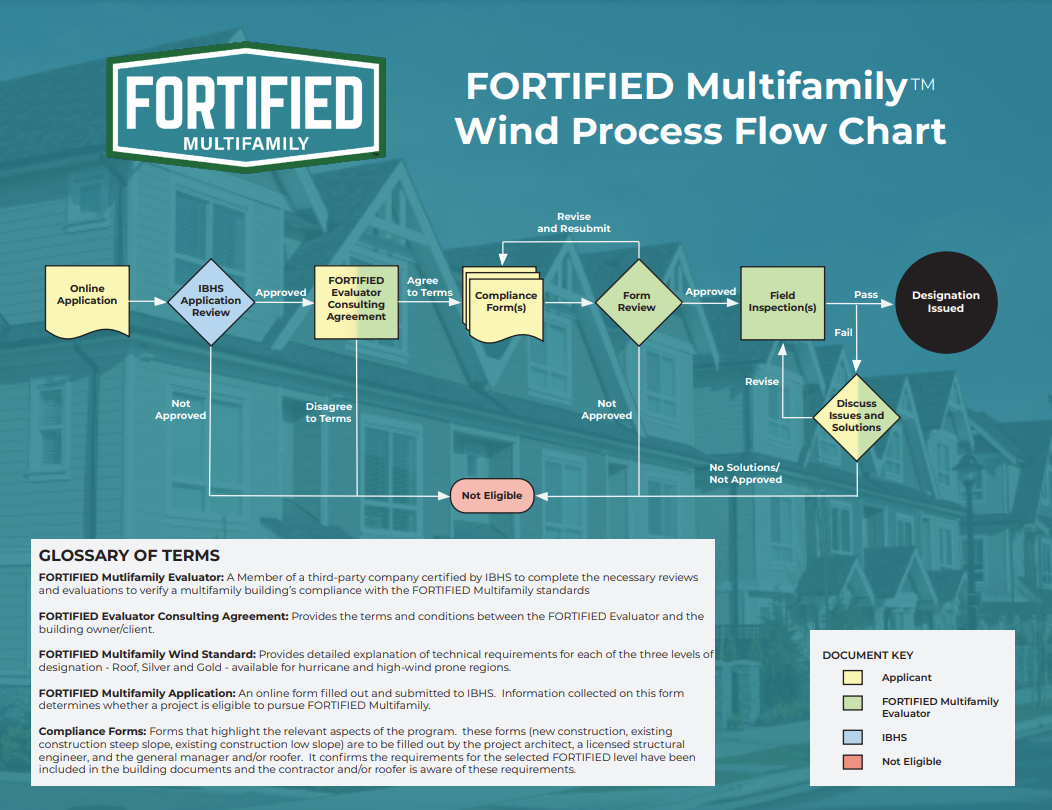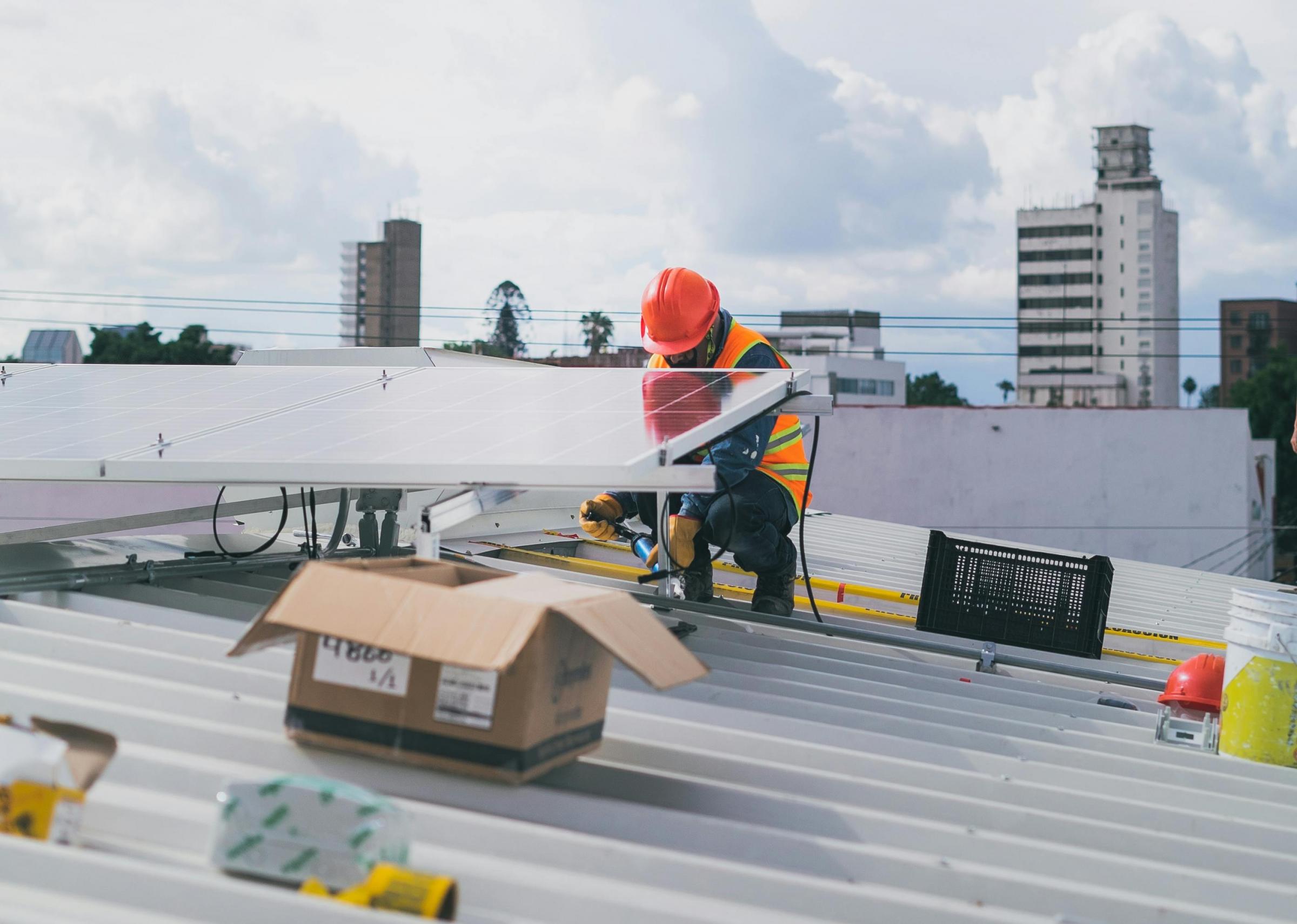Overview
Colorado's frequent hailstorms and high-wind events pose challenges to the durability and financial viability of multifamily affordable housing. Achieving a FORTIFIED™ Multifamily designation with the Hail Supplement from the Insurance Institute for Business and Home Safety can substantially mitigate these hazards.
As of early 2025, Colorado does not have a multifamily building that has achieved the FORTIFIED™ certification. The Spark, a high-performance office building in Madison, Wisconsin, has a roof assembly similar to many multifamily properties with a flat roof design.
Certified under the IBHS FORTIFIED™ Commercial Gold standard with the Hail Supplement, this 158,000-square-foot building consists of eight levels of post-tensioned concrete framing. Key features of the building include hail-resistant roofing, which utilize materials that meet rigorous impact testing standards to withstand large hailstones. Additionally, advanced sealing techniques on the roof decks prevent water intrusion, even if the outer roof layer is compromised. All roof-mounted equipment is impact-rated to withstand hail impacts, ensuring critical systems remain functional.
Beyond hail protection, the IBHS FORTIFIED™ Gold Standard integrates high-wind resistant measures, such as enhanced roof attachment systems, reinforced connections between structural elements, and continuous load paths to withstand uplift and lateral forces during extreme weather events. These design strategies not only increase safety and building longevity, but also reduce repair costs, improve insurance viability, and contribute to the long-term sustainability of housing and commercial developments.
Although it is a commercial building rather than a multifamily development, The Spark building’s resilience strategies offer valuable insights for affordable housing projects in Colorado. Given the similar climate risks—especially hail and high winds—these strategies can enhance durability, energy efficiency, and occupant safety in the state’s affordable housing sector.
Key elements to achieving the IBHS FORTIFIED™ Gold Standard with the Hail Supplement include:
Hail-resistant Roofing Systems
- Utilize roofing materials that are designed to reduce the risk of roof damage from hail impacts and subsequent water intrusion.
Steep Slope Roofs:
- Shingles must meet a minimum rating of Good or Excellent on the IBHS Roof Shingle Hail Impact Rating Scale.
- Clay and concrete roof tiles must meet FM 4473 Class 4 impact rating.
- Metal panel roofs must meet UL2218 Class 4 impact rating.
- All other roof coverings must meet either UL 2218 Class 4 or FM 4473 Class 4.
Low Slope Roofs:
- Low-sloped (≤10°) continuous roof covers must meet one of the following test standards:
- FM Approval Standard 4470 with a Class 1-SH or 1-VSH
- UL 2218 Class 4
- Ensure that roofing materials are installed according to manufacturer specifications and FORTIFIED™ guidelines to maximize the roof’s hail performance. Implement a sealed roof deck on steep slope roofs to prevent water intrusion in case of roof cover damage (shingles, tiles, metal panel, etc.).
Roof-mounted Equipment Protection and Skylights
- Install protective hail guards on roof-mounted HVAC equipment to prevent damage to condenser coils and fan blades during hailstorms. This measure helps maintain system efficiency and reduces repair costs.
- Install impact rated skylights that meet:
- ASTM E1886 and ASTM E1996 missile impact rated B, C, D, or E
- FM Approved per ANSI/FM 4431, with Severe Hail Rating
Wind-resistant Construction Practices
- Install a stronger roofing system designed to provide better protection against severe wind:
- Steep Slope: Install a high wind rated roof cover.
- Low Slope: Install a tested and approved roof cover system with an additional factor of safety.
- Reinforce roof connections using ring-shank nails to improve attachment strength and reduce the risk of uplift during high winds.
- Establish a continuous load path by connecting the roof, walls, and foundation, ensuring that the building can resist lateral and uplift forces during severe winds.

Evidence Based Benefits
Investing in FORTIFIED™ standards for wind and hail resilience provides a measurable return on investment for developers and communities.
Repair Cost Reduction - The Colorado insurance industry is shifting its approach to hail policy deductibles, transitioning from flat-rates to five percent of total property value. This significantly increases the portion of building repair costs that must be covered by the owner. Research from the Insurance Institute for Business & Home Safety (IBHS) shows that impact-resistant roofing materials, sealed roof decks, and proper installation techniques minimize damage, cutting repair costs by up to 50 percent compared to conventional systems.
Long-term Asset Viability - Hailstorms are expected to intensify due to more volatile atmospheric conditions, with hailstones growing larger and the frequency and severity of hail and wind events increasing. FORTIFIED™ standards help ensure that affordable housing developments remain viable as climate risks evolve. Properties built to FORTIFIED™ standards demonstrate a proactive approach to disaster resilience that can appeal to investors, lenders, and insurers. Conversations with insurance brokers indicate that third-party verified hazard mitigation strategies can reduce the chance of insurance non-renewal.
Research from leading organizations, including the Insurance Institute for Business & Home Safety (IBHS) and the National Institute of Building Sciences (NIBS), highlights the financial and societal benefits of adopting resilient building practices. These studies demonstrate that the upfront costs of implementing FORTIFIED™ measures, such as impact-resistant roofing and enhanced structural connections, are offset by long-term savings through reduced repair costs, lower insurance premiums, and increased property values.
- National Institute of Building Sciences (NIBS) Report: This report indicates that investing in stronger roofs and building standards, such as FORTIFIED™, can save $5 for every $1 invested.
- University of Alabama Study: Research demonstrates the significant financial benefits of implementing FORTIFIED™ standards in multifamily construction. According to a University of Alabama study, the additional construction costs for adopting FORTIFIED™ standards range from just 0.29 percent to 1.43 percent of a building’s total cost, depending on the designation level and location. These upfront expenses can be offset by long-term savings through reduced insurance premiums and lower repair costs. With returns on investment ranging from 8.1 percent to 72 percent, FORTIFIED™ standards provide a cost-effective strategy for multifamily developers to improve building resilience and ensure the long-term stability of affordable housing communities.
